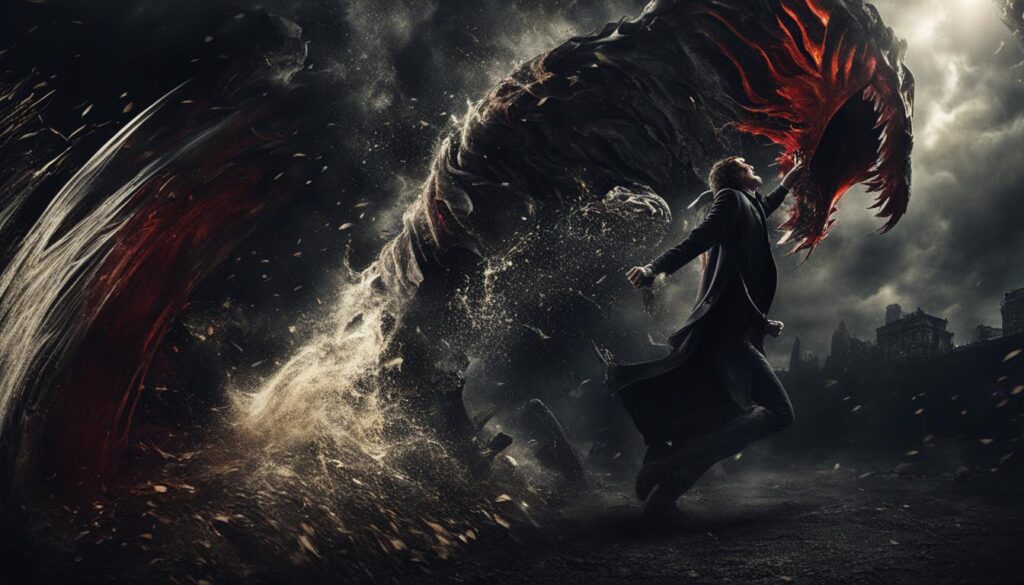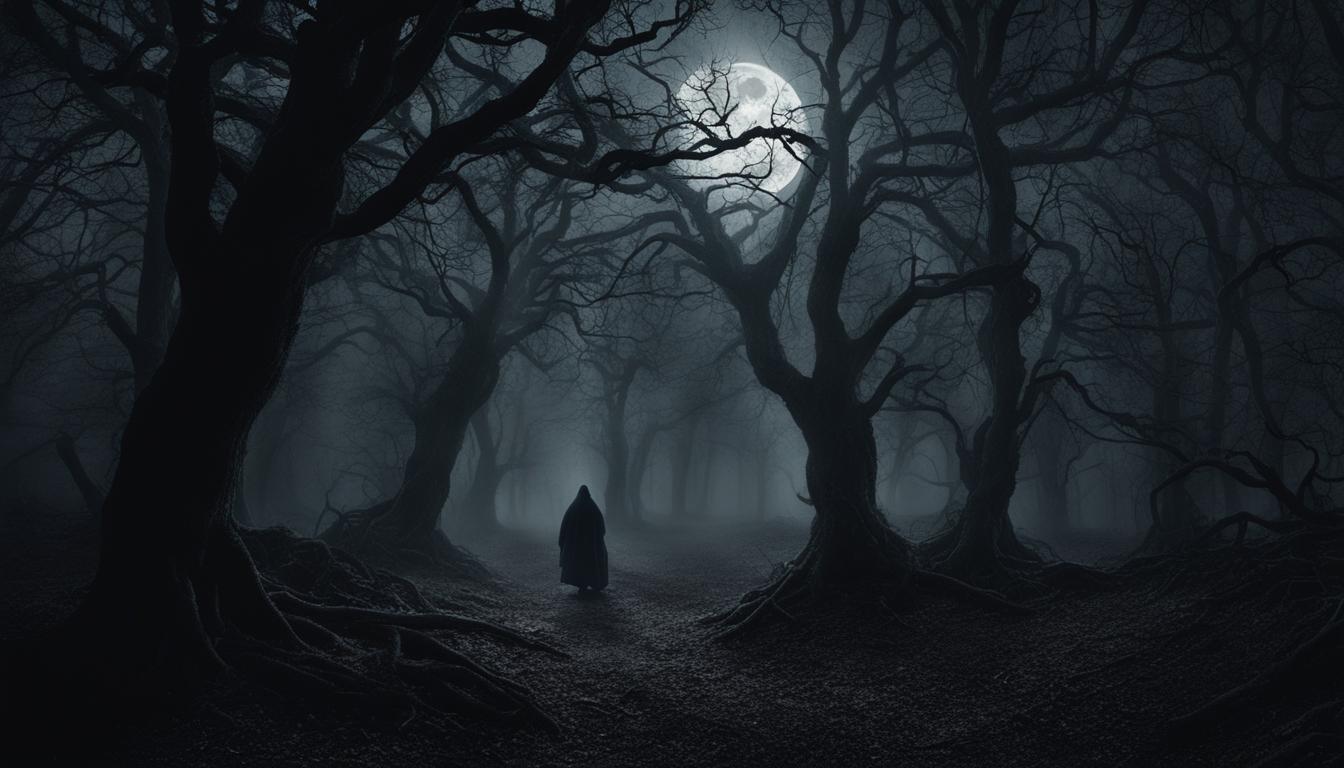In his thought-provoking essay “Why We Crave Horror Movies,” Stephen King explores the darker side of our human nature and our enduring fascination with horror movies. King’s well-crafted arguments shed light on the reasons why so many individuals are drawn to this genre of film, despite its terrifying subject matter. This section will delve into the insights provided by King and examine why horror movies continue to captivate audiences worldwide.
The Psychology of Fear
Fear is a primal emotion that has been deeply ingrained in the human psyche since the dawn of time. In today’s modern society, this fear is often manifest in our obsession with horror movies. But what causes us to seek out fear in the first place? According to Stephen King, it all comes down to the psychology of fear.
King argues that at the heart of our fascination with horror movies lies the desire to confront our fears in a controlled environment. By exposing ourselves to scary situations in the form of movies, we can experience the adrenaline rush and emotional release that comes with facing our fears head-on without any real-world consequences.
But why do we enjoy this experience so much? From an evolutionary perspective, our fascination with fear can be linked to our primitive fight-or-flight response. When faced with a potential threat, our bodies release adrenaline and other stress hormones to help us prepare for the danger. Horror movies allow us to experience this same rush of adrenaline and excitement without actually being in any danger, which can be both thrilling and cathartic.
When it comes to horror movies specifically, there are certain psychological factors at play that make them especially effective at eliciting fear. For example, many horror movies play on our deepest fears and anxieties, such as the fear of the unknown or the fear of death. They also often use jump scares, suspense building, and other techniques to keep us on the edge of our seats and heighten our emotional response.
Overall, the psychology of fear is a complex and fascinating subject that sheds light on our enduring fascination with horror movies. By understanding the role that fear plays in our psyches, we can gain a deeper appreciation for why we crave the thrill and excitement of the horror genre.
Catharsis Through Horror
Horror movies evoke a range of emotions, from fear to disgust, but perhaps one of the most unexpected benefits of the genre is its ability to provide catharsis to viewers. For many people, horror movies offer a form of emotional release, allowing them to confront and cope with their own fears and anxieties.
Studies have shown that experiencing fear through horror movies can lead to a sense of relief and even pleasure, as the body releases adrenaline and other stress hormones. This physiological response can be cathartic, providing a way for viewers to release pent-up emotions in a safe and controlled environment.
| Benefits of Catharsis Through Horror |
|---|
| 1. Effective form of self-therapy |
| 2. Opportunity to confront and process difficult emotions |
| 3. Empowerment through overcoming fear |
Moreover, horror movies can provide a sense of empowerment to viewers. By facing and overcoming their fears vicariously through the characters on screen, viewers may feel a sense of accomplishment and mastery over their own anxieties.

Overall, the cathartic experience of horror movies is a unique and valuable aspect of the genre, providing viewers with a temporary escape from the pressures of everyday life and a means of processing their own emotional experiences.
Evolutionary Perspective on Fear
Why do we enjoy watching horror movies when they trigger our fear response? Evolutionary psychology provides insight into our fixation with fear-inducing situations. When our ancestors were faced with immediate danger, their bodies would trigger the “fight or flight” response to increase their chances of survival. This response floods our bodies with adrenaline, making us hyper-aware and ready for action. Today, we rarely face true life-or-death situations, but our bodies still respond the same way to fear-inducing stimuli.
Horror movies provide a controlled environment for us to experience this thrill, without actually being in danger. Our brains understand this, and we feel alive and invigorated after the experience. From an evolutionary standpoint, seeking out fear and excitement is a form of adaptive behavior. It allows us to hone our instincts in a safe environment and better prepare for future threats.
Stephen King explores this idea in his essay, “Why We Crave Horror Movies,” stating that “the horror film is innately conservative, even reactionary… slyly insisting the only catharsis we can afford comes from watching the implacable struggle between good and evil on our screens.” Therefore, our love for horror movies may be a reflection of our primal needs for control and survival, as well as a way to fulfill our desire for catharsis.
Escapism and Thrill-seeking
Horror movies have always been a form of escapism for movie-goers, offering an opportunity to step into a different world and escape reality for a while. However, the appeal of horror movies goes beyond simple escapism, as many viewers seek out the rush of adrenaline and excitement that comes with being scared.
Some psychologists argue that thrill-seeking behavior is innate to humans and is linked to our evolutionary past, where seeking out potential danger and excitement was necessary for survival. In the modern world, this instinct manifests in our attraction to extreme sports, rollercoasters, and, of course, horror movies.

The rush of adrenaline that comes from watching a horror movie can be addictive, leading some individuals to actively seek out increasingly intense and terrifying experiences. This behavior can be especially prevalent in individuals who have low levels of stimulation in their everyday lives, as they may turn to horror movies as a means of spicing up their routines and adding some excitement to their lives.
Whether it’s for the thrill of the scare or the chance to escape into a different world for a while, the appeal of horror movies is undeniable.
Societal Impact of Horror Movies
Horror movies have been a subject of debate in terms of their societal impact. One of the main concerns is the potential for desensitization among viewers. The continuous exposure to graphic violence and gore may result in individuals becoming numb to the once-shocking content.
Research has shown that exposure to violent or disturbing media can lead to desensitization and an increase in aggressive behavior. However, the extent to which horror movies contribute to this phenomenon is still up for debate.
| Positive Impact | Negative Impact | |
|---|---|---|
| Societal impact of horror movies | Can spark conversations about societal issues and encourage critical thinking. | Can lead to desensitization, which may result in increased aggression and desensitization to real-life violence. |
| Individual impact of horror movies | Can provide a safe way for individuals to confront and process their fears. | Can cause increased anxiety and trauma for some individuals. |
It is important to note that horror movies, like any form of media, can have both positive and negative effects on society and individuals. It is up to filmmakers and viewers to be aware of the potential impact and to use caution when consuming and creating content.
Entertainment vs. Disturbing Content
Horror movies, by nature, attempt to explore the boundaries of what is acceptable and what is not. Filmmakers push the limits with gory scenes, violence, and disturbing content, all in the name of creating an entertaining and thrilling experience. However, there is a fine line between providing entertainment and crossing into truly disturbing content.
Some audiences seek out horror movies as a way of confronting their fears and experiencing a sense of catharsis. Others crave the adrenaline rush of a good scare. But where do we draw the line between entertainment and excessive violence or gore?
Some argue that there should be no boundaries to artistic expression, while others feel that filmmakers have a responsibility to avoid glorifying disturbing content. As viewers, we must navigate this delicate balance between entertainment and what is socially acceptable.
Ultimately, it is up to the individual viewer to decide their own boundaries when it comes to horror movies. While many may find enjoyment in the thrill of a well-crafted horror film, it is important to understand that different people have different levels of tolerance when it comes to disturbing content.
Examples of Disturbing Content in Horror Movies
| Disturbing Content | Examples in Horror Movies |
|---|---|
| Graphic Violence | The Saw franchise, Hostel |
| Sexual Violence | The Last House on the Left, The Hills Have Eyes |
| Torture | Martyrs, A Serbian Film |
While some may argue that these extreme examples of disturbing content have a place in horror cinema, others may find them gratuitous and disrespectful. Ultimately, it is important for filmmakers and viewers to consider the potential impact of the content they consume and create, and to strive for a balance between entertainment and responsible storytelling.
Horror as Art
While horror movies have traditionally been dismissed as mere popcorn entertainment, there is increasing recognition of their artistic worth. The genre’s use of suspense, atmosphere, and chilling themes has given rise to a new appreciation for horror movies as a form of art.
One of the defining features of horror as art is its ability to elicit strong emotional responses and provoke thought. Filmmakers often use horror to explore societal issues and universal fears, presenting them in a fresh and innovative way. This approach has led to groundbreaking works of art that have left a lasting impact on audiences.
Moreover, the techniques employed by horror filmmakers are highly sophisticated. From expertly crafted sound design to carefully constructed cinematography, these elements work together to create a powerful and immersive experience for viewers.
Perhaps most importantly, horror movies challenge our preconceptions of what is considered “art.” By embracing the macabre and exploring the darkest aspects of the human psyche, horror movies push the boundaries of what is socially acceptable, sparking debate and reflection.
As Stephen King argues in his essay “Why We Crave Horror Movies,” horror offers a unique opportunity for artistic expression, challenging us to confront our deepest fears and embrace the unknown.
Conclusion
Stephen King’s essay “Why We Crave Horror Movies” offers a unique perspective on our fascination with the macabre. King argues that our love for horror movies stems from a desire to confront our deepest fears and anxieties in a safe and controlled environment.
Throughout the essay, King explores the psychology behind our fear and how it is portrayed in movies. He also explains how horror movies provide a means of catharsis for viewers, allowing them to release their pent-up emotions. Moreover, King notes the evolutionary aspect of fear and how our primal instinct to seek out danger and excitement plays a role in our enjoyment of horror movies.
King also discusses the entertainment value of horror movies and the line between entertainment and disturbing content. He examines the influence of horror movies on society and debates on desensitization. Finally, King delves into the artistic value of horror movies, examining the techniques and themes that elevate the genre to a form of art.
In conclusion, Stephen King’s perspective on our love for horror movies offers valuable insights into the human psyche and the role that fear and entertainment play in our lives. King’s essay challenges us to explore our own fears and emotions, and to question the limits of the horror genre as a form of artistic expression.



